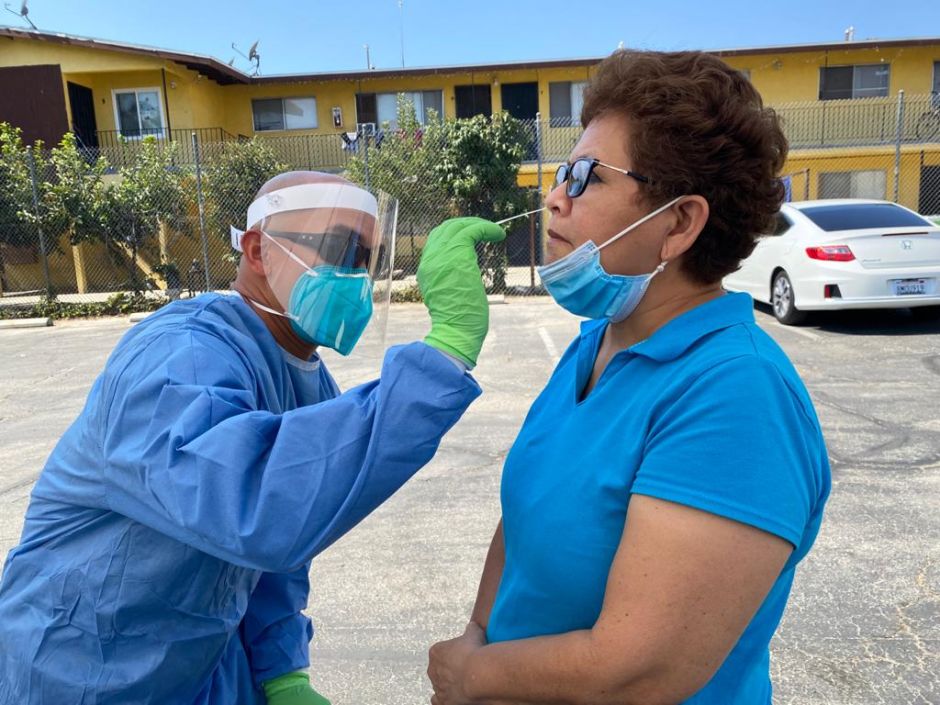Mobile unit will travel through low-income areas; leaders emphasize that no questions about immigration status are asked for the test
As part of a partnership with the Coalition for the Human Rights of Immigrants (CHIRLA) and the city of Long Beach, dozens of emergency medical technicians conducted COVID-19 tests among low-income and undocumented residents on Saturday.
With fear of the unknown on their faces, dozens of nervous residents arrived at Washington Middle School in Long Beach yesterday to be examined by health technicians Mark Tabi and Bronson De Guzmán.
“I was afraid that they would bite me hard,” said the boy Evan Mejía, 11, who underwent the test, along with his sister Vanessa, 13, and his mother, María, a housewife originally from Jalisco, Mexico and neighbor of Long Beach.
The mayor of that city, Robert García, launched a new COVID-19 testing strategy to reach undocumented and underserved residents.
“As far as we have seen, Latinos and African Americans have the highest rates of infection,” Councilor Mary Zendejas told La Opinion.
“It’s sad, but in the Latino culture there is mistrust. They don’t feel comfortable [de ir a hacerse las pruebas] and, furthermore, they are afraid that they will be asked something related to their immigration status and that is not true ”, and emphasized that no information related to this issue is requested.

In figures
As of September 25, Long Beach had 11,798 positive cases of COVID-19; 44 people were hospitalized and 245 have died since the start of the pandemic.
Of the total of 809,000 COVID-19 cases in California, 61% correspond to the Latino population (that is, 283,6000). However, this community only represents 40% of the total population of the Golden State.
Mayor Robert García himself saw that disparity in contagions reflected in his person. He lost his stepfather and mother to the coronavirus and hopes the new mobile testing model will influence minority communities to replace fear with trust.
His message was echoed by Hilda Ortiz, 58, of Guerrero, Mexico, who arrived accompanied by her husband Javier, 60, from Chihuahua. They own a grocery store in Long Beach.
“We are essential workers, we take care of ourselves and the people of our community who come to our store,” said Hilda.
“We have to motivate the community so that they are not afraid and take the test.”
That fear is precisely what has prevented immigrants from coming to receive the test that is free and confidential.
“All the tests are collected and sent to Fulgent Genetics laboratories,” in Temple City, reported Victoria Vielma, who is an emergency medical technician.
For her, young people are also a population that causes concern, “because they think they are invincible and they feel that they are healthy and that nothing is going to happen to them.”
In fact, Cal State University Long Beach quarantined all students living on campus after five of them tested positive for COVID-19, including four who live in college dorms.
“We learned of several students who did not heed our guidance regarding COVID-19 precautions and socially congregated off campus earlier this month,” CSULB president Jane Close Conoley said in a statement.
Over the course of the next few weeks and months, medical technicians will travel in the COVID-19 mobile unit to go directly to the Long Beach communities where immigrant and African American residents live, particularly in zip codes 90813; 90806; 90805; 90804 and 90802, where
have registered the highest number of infections.
For now, Mrs. Lucia Martínez, who works as a cleaner in a house in the Bisby Knolls apartment complex, has already undergone the coronavirus test.

“The owners of the house where I work asked me to bring them the paper where it says that I am not infected,” he said.
The same happened with Brandon Jones, a 31-year-old African-American man, who has been homeless for seven and a half years.
“At the shelter center they want me to show them that I don’t have the virus; otherwise they told me they would not let me in, ”said the man, after they applied a swab for 10 seconds in each of his nostrils.





